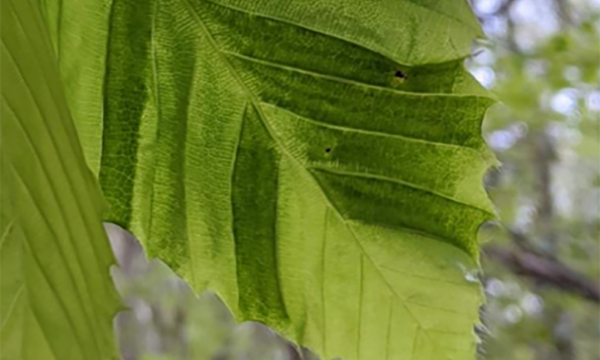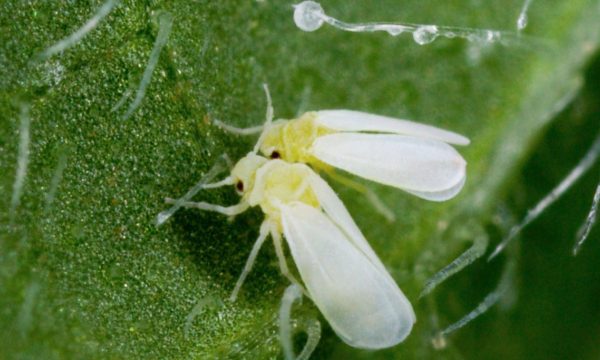Project news Plant attacker of the month February: the fruit fly Bactrocera dorsalis
Bactrocera dorsalis is a small fly species (length: 8 mm) from the family of fruit or borer flies (Tephritidae). It is an originally non-European insect species whose presence within Europe is to be avoided at all costs. This fruit fly can affect many fruit species and consequently cause great economic damage in the European fruit growing and horticultural sector. That has led to the application of very strict measures to prevent the introduction of Bactrocera dorsalis in Europe .

De wijfjes leggen met hun legboor eitjes af net onder de vruchtschil (zie afbeelding). Uit deze eitjes komen larven die zich voeden met het vruchtvlees en zo enorme oogstverliezen veroorzaken. Beschadigde vruchten herken je doordat een bruine vlek ontstaat rond het boorgaatje waarin het eitje werd afgelegd. Uiteindelijk wordt de volledige vrucht rot.
Bactrocera dorsalis, en met uitbreiding ook andere niet-Europese vruchtvliegen, worden in België regelmatig vastgesteld tijdens de invoercontroles op plantaardige producten, zogenaamde ‘fytosanitaire controles’, aan onze grensinspectieposten. De insleep van deze uitheemse vruchtvliegen gebeurt in hoofdzaak via hun larven die tot 10 mm groot worden (zie afbeelding) en verscholen zitten in ingevoerde vruchten van o.a. mango, paprika, annona en sinaasappel. Bacterocera dorsalis is momenteel niet aanwezig in onze contreien, maar werd voor het eerst in grote getale in Europa vastgesteld in 2018, meer bepaald in een veld in Italië. Men vermoedt dat de introductie van deze vliegensoort er via de invoer van besmette vruchten is gebeurd. Het is daarom van groot belang dat men geen vruchten uit niet-Europese landen eigenhandig meebrengt naar Europa.
Om insleep van dit invasieve insect te voorkomen, worden fytosanitaire controles door het federaal voedselagentschap (FAVV) uitgevoerd en verdachte stalen worden dan verder door het ILVO gecontroleerd op aanwezigheid van B. dorsalis of andere niet-Europese vruchtvliegen. Bij vaststelling van dergelijke vruchtvliegen moet de lading worden vernietigd. Dit voorkomt de mogelijke introductie en verspreiding van niet-Europese vruchtvliegen in onze contreien. Recent werd er aan het ILVO een onderzoeksproject gestart om de identificatie van de larven van deze vruchtvliegen sneller te kunnen uitvoeren (FOD-project ‘TEPHRIFAST’).
The females lay eggs with their ovipositor just under the fruit skin (see image). Larvae hatch from these eggs and feed on the flesh, causing enormous harvest losses. Damaged fruit can be recognized by a brown spot around the hole where the egg was laid. Eventually the whole fruit will rot.
Bactrocera dorsalis, and by extension also other non-European fruit flies, are regularly detected in Belgium during import checks on plant products, the so-called 'phytosanitary controls', at our border inspection posts. The introduction of these non-European fruit flies is mainly done by their larvae, which can grow up to 10 mm in size (see picture) and are hidden in imported fruits such as mango, sweet bell pepper, orange and annona species such as soursop, cherimoya and sugar apple. Bacterocera dorsalis is not currently present in our area, but was first identified in large numbers in Europe in 2018, specifically in a field in Italy. It is suspected that the introduction of this fly species there was through the import of infected fruits. It is therefore very important not to bring fruits from non-European countries into Europe on your own.
To prevent the introduction of this invasive insect, phytosanitary checks are carried out by the Federal Food Agency (FASFC) and suspected samples are further checked by the ILVO for the presence of B. dorsalis or other non-European fruit flies. Upon detection of such fruit flies, the cargo must be destroyed. This prevents the possible introduction and spread of non-European fruit flies in our region. Recently ILVO started a research project to speed up the identification of the larvae of these fruit flies (FOD project 'TEPHRIFAST').



